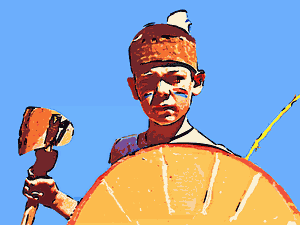source: www.youthwork-practice.com | 2000 Games, Devotions, Themes, Ideas and more for Youth Work
only for private using
Indian terrain games
For the Indian terrain games, the players dress themselves in their self-made outfits and war paint. Each tribe brings a totem pole and a wigwam (3 sticks and a white sheet).
-
Stealing the totem pole

Each Indian tribe searches for a place to set up camp. The camp is marked out using 3 pyramid formed sticks. A white sheet is stretched over the camp. The totem is placed in this “wigwam”. The task for each tribe is now to steal the totem from the other tribes and to defend their own totem. There is a member of staff in each camp acting as a referee. Other members of staff are spread out throughout the area as referees. Each Indian receives a scalp (life ribbon) tied around their left arm. The second aim of the game is collected as many stranger’s scalps as possible. Anyone who no longer has a life ribbon cannot fight further, but must collect a new scalp from a member of staff. The playing field should be approx. 300x300 m large – maximum 1000x1000m, depending on the group numbers and terrain. The stolen scalps can be collected and hidden somewhere in the playing area and are handed in at the end of the game to be counted. The game can be a draw if one tribe has managed to steal the totem but the other team has stolen lots more scalps.
-
Indians on the war path
In this terrain game there are Indian tribes, groups of settlers and single gold hunters. The Indians have a “thread of life” wrapped around their left arm (possibly also a coloured feather) the settlers have it wrapped around their right arm (with small piece of leather or fur). The task which the settlers/gold hunters face is to find some gold treasure. The Indian’s task is to gather up as many scalps (pieces of leather) or glass pearls/or as much fire water as possible. The Indian can decide if he scalps the settler (take the leather) or if he trades him in for a couple of glass pearls, fur or fire water. If two Indians come across a settler, they can take his life thread and the pearls. That is only possible if the Indians are clearly in the majority (2:1). The settlers or gold hunter can decide if they want to scalp the Indian or trade him in for some fur/leather. The scalps and furs can be swapped against information in the stores. The information gives clues to the whereabouts of the treasure. There are extra clues in exchange for 5-10 scalps. If a settler loses his scalp and must collect a new one, he loses another scalp. This means that the settlers/gold hunters must always make sure that they have 5-10 scalps in reserve. If an Indian loses his scalp he must collect another one back at the camp from a member of staff. Each Indian carries a few replacement pieces of leather for swapping. The relation of Indians to Settlers/gold hunters should be 2:1 or 3:1.
-
Ruining railway tracks
Tapes are laid out in the woods making straight lines between trees. These represent the railway tracks. The guards try to protect the railway tracks while the Red Indians try to wreck them (by removing the single tapes). If all tapes are removed, the Red Indians have won.
-
Bison hunt
The camp leaders each receive 10 pieces of fur or pieces of leather ( if you don’t have any fur/leather, beer mats can also be used) and are sent on their way to spread out and or hide themselves in the woods (size of playing area approx. 300x300 meters depending on number of players). The group members receive a beer mat as a spear (yes – you must use your imagination). With this spear (beer mat) the bison are hunted. Anyone who strikes a bison receives a piece of fur (or specially marked beer mat) handed out and the bison (member of staff) keeps the spear (beer mat). The successful Indian swaps his piece of fur for a new spear (in the stores – at the tent). The winner is the Indian tribe which has hit the most bison. The prize is an extra feather.
[ © www.youthwork-practice.com | 2000 Games and Ideas for Youth Work ]






